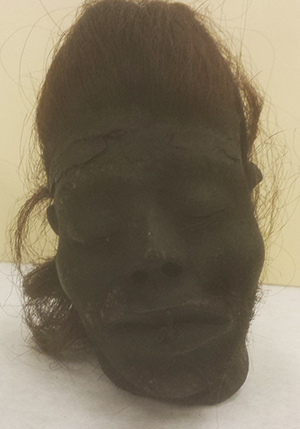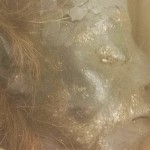The Mystery of the Shrunken Head
By Chrissie Perella

For the past several weeks, I've been processing the extensive Hartwig
Kuhlenbeck collection. Kuhlenbeck, born in Germany in 1897, was Professor of
Anatomy and, later, Emeritus Professor at Woman's Medical College, and
served as Major of the Medical Corps of the United States Army during World
War II. He traveled all over the world, including the Alps, Alaska, the
South Pacific, India, South America, and spent several years in Japan at the
Imperial University and Keio University in Tokyo as Dozent of Anatomy and
Comparative Neurology during the 1920s. He's an interesting man with an
interesting collection. While Kuhlenbeck deserves an entire blog post to
himself, one item in his collection is just begging to be written about.
Kuhlenbeck saved various memorabilia from his travels: souvenir postcards
and stationery, maps, museum booklets, hotel receipts. Fun stuff to look
through, and much the same as we save from our vacations today.
In 1951, Kuhlenbeck spent several months in South America, lecturing (in
Spanish, of course) at the Neurological Clinic of the University of
Montevideo, Uruguay; the Hortega Institute in Buenos Aires, Argentina; and the
Universities of Santiago and Concepcion in Chile. He visited "a number of
additional Medical Schools and Scientific Institutions...[to collect] material
for comparative neurological study." He also collected a shrunken head,
allegedly from the Jivaro people.
The Jivaro are South American Indian people living in Ecuador and Peru, north
of the Marañón River in the eastern part of the Andes mountains. They are
war-like and well-known for their talent of shrinking heads to the size of
apples.1 Kuhlenbeck described the
head-shrinking process as such:
In the manufacture of the skin tsantsas, the separated head is split by a
cut from the apex across the occiput to the rear end of the neck stump and
carefully peeled away from the skull; the skinned skull is thrown away.
The skin sack is then cooked for several hours in a boiler, where water
and plant juices, known to the Indians as conducive to shrinkage, are
mixed. Then the head-hunters sew the incision to guide the peeling skin
and again achieve a further shrinkage, and at the same time shape [the
head] by placing hot stones in the neck opening of the skin sack, and roll
the stones back and forth. Furthermore, the outer side of the head is
flattened with smooth stones and modeled. Finally, hot sand is poured
through the neck opening into the interior of the hollow head; so that the
final drying and shrinkage is caused, which can be completed by a kind of
incense on the fire.
During his visit to Ecuador, Kuhlenbeck wrote in his Tagebuch
about the day he purchased the shrunken head:
An old Indian woman, sitting there on a blanket spread out on the street,
offers a variety of handicrafts for sale at which I look. As I exchange a
few words with her, she pulls out of a basket a blackish, shrunken head,
the size of a small human fist, with a long dark mop of hair, which she
offers to sell to me for a few dollars...It is apparently one of those
designated as Tsantsa Trophies of the Jivaro (Jibaros), the wild
Indian tribes of the tropical jungle in the upper Amazon.
Clearly not as skeptical as some would be when offered such merchandise for a
measly few dollars, Kuhlenbeck seemed to believe it was the real deal:
The head, which the squaw offers to me, is obviously true – it shows the
face of a young person of about 20 to 30 years, with slightly Negroid and
some feminine traits. I am therefore not quite sure if it was a young man
or is a woman. In the latter case, the value would only have been a very
little as a trophy for the Jivaro. Also, it is probably a half-breed head,
perhaps the one Zambos. The lips are sewn, as is generally the case with
these heads, with only a single thread loop. Nevertheless, this shrunken
head offered to me is an unusual showpiece with an almost living facial
expression. Therefore, I pay the high price and put the head, like an
apple, in my coat pocket.

Now, meet Jürgen Jivaro (we here at the Legacy Center have dubbed it as
such, feeling it needed a name). The question is, "Is it authentic?"
Authentic in this case - a true tsantsa - means a shrunken human
head prepared with correct ceremonial and religious rituals by the Jivaro
people. I'm still undecided, but signs are pointing to it being a forgery -
whether human, it's very difficult to tell.
My first foray into Jürgen's authenticity was to find out what Kuhlenbeck
himself had written; luckily for me, he mentioned the date of his South
American tour in a short autobiography. From there it took several hours of
paging through his Tagebuch (day book, literally) until finding
some mention of the Jivaro - a tough task considering my German is a bit
rusty! With the help of Google Translate (quite possibly, the bane of
foreign language teachers everywhere), I soon discovered the means by which
Kuhlenbeck acquired Jürgen (as excerpted above).
Well, Kuhlenbeck seemed to harbor little doubts as to the authenticity of the
shrunken head, but that didn't settle it for me. So I did some digging. One
helpful article, "Shrunken head (tsantsa): A complete forensic analysis
procedure," listed diagnosis criteria for authenticating shrunken heads.
Jürgen fit only four of these criteria well.2
Another article, a case study written in 1975 about two shrunken heads in the
nearby Mütter Museum3, seemed to present evidence that Jürgen is not authentic.
So what did I find out about authentic tsantsa and forgeries? A
‘forgery’ or ‘fake’ can be either a shrunken human head not prepared with the
correct ritual (sometimes referred to as “tourist heads”2) or one made of an animal head (commonly sloth); animal hide; or even
plastic.3Here's what I found about our shrunken head, and why I
believe it's not authentic, but (best case) a "tourist head" or (worst case) a
fake composed of animal skin.
While Jürgen's skin is smooth and polished with what could be charcoal, and
there are stitches up the back of its head, it is clearly missing some
qualities authentic shrunken heads share. Yes, it's not uncommon for the hair
to be cut or for the string attached to the top of the head to be absent.
However, while Jürgen's ears seem to be blocked with some sort of material,
they're not pierced. Its eyes are not completely shut, let alone sealed. This,
and the fact that its lips are sewn through with only one thread as opposed to
three, seem to point to the head being a forgery. The Jivaro made certain the
lips and eyes were sealed and sewn tight to ensure the spirit could neither
see nor escape. Additionally, the thumb-sized depressions found on the temples
of authentic tsantsas are not noticeable.23

Blocked, unpierced ear

Side view showing eyes and lack of depression

Back of head showing stitching
Kuhlenbeck also mentioned that the shrunken head he purchased had "an almost
living facial expression." It has been stated that the Jivaros would
purposefully distort the heads to ridicule their enemies and made no attempts
to make the facial expressions look 'alive.'3
All this evidence leads me to believe Jürgen is a forgery, much as I would
like it to be authentic. Without the use of high-powered microscopes or DNA
testing, we probably won't know whether it is a human head. So what do you
think? Is Jürgen authentic or just a clever forgery?
1"Jívaro."
Encyclopaedia Britannica. Encyclopaedia Britannica Online. Encyclopædia
Britannica Inc., 2014.
2Charlier, P.; Charlier, I-Huynh; Brun, L.;
Herve, C.; and de la Grandmaison, Lorin.
"Shrunken head (tsantsa): A complete forensic analysis procedure.”
Forensic Science International, 222 (2012): 399e1-399e5.
3Mutter, George L.
"Jivaro Tsantsas, Authentic and Forged: A Study of Two Shrunken Heads in
the Mütter Museum."
Transactions & Studies of the College of Physicians of Philadelphia
43, no. 2 (1975): 78-82.